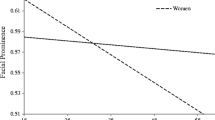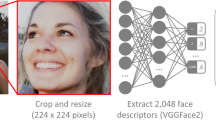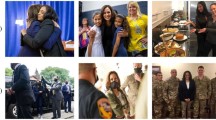Abstract
This study investigates the emotional content of facial images of South Korean politicians. The data were drawn from official websites of 18th National Assembly members. We categorized facial expressions (smiling, frowning, and no expression) by using photos on the websites. The smiling image was the most prevalent facial expression regardless of the socio-political-demographic attributes of the politicians. The existence and strength of the smiling image had significant positive correlations with the politicians’ web visibility. Opposition parties were significantly more likely to show frowning or expressionless images than the ruling party. The more experienced politicians were more likely to continue their use smiling images than similarly aged politicians with less experience.
Similar content being viewed by others
References
Angus, E., Stuart, D., Thelwall M.: Flickr’s potential as an academic image resource: an exploratory study. J Librarian Inf Sci (2011, in press)
Bauer M.: Classical content analysis: a review. In: Bauer, M.W., Gaskell, G. (eds) Qualitative researching with text, image and sound, pp. 131–151. Sage, Thousand Oaks, CA (2000)
Choi S., Lehto X.Y., Morrison M.A.: Destination image representation on the web: content analysis of macau travel related websites. Tourism Manag. 28, 118–129 (2007)
Coleman R., Wasike B.: Visual elements in public journalism news-papers in an election: a content analysis of the photographs and graphics in campaign 2000. J. Commun. 54(3), 456–473 (2004)
Davis F.: Perceived usefulness perceived ease of use and user acceptance of information technology. MIS Quarterly 13(3), 319–340 (1989)
Druckman J., Kifer M., Parkin M.: The technological development of candidate websites: How and why candidates use web innovations. Social Science Computer Review 25, 425–442 (2007)
Druckman J., Hennessy C.L., Kifer M.J., Parkin M.: Issue engagement on congressional candidate websites (2002–2006). Social Science Computer Review 28(1), 3–23 (2010)
Foot K., Schneider S.M.: Web campaigning. MIT Press, Cambridge, MA (2006)
Govers R., Go M.F.: Projected destination image online: website content analysis of pictures and text. Inf. Tech. Tour. 7(2), 73–89 (2004)
Hayes A.F., Krippendorff K.: Answering the call for a standard reliability measure for coding data. Commun. Method Measure 1(1), 77–89 (2007)
Heaney M.T., Newman M.E., Sylvester D.E.: Campaigning in the Internet Age. In: Craig, S.C. (ed.) The electoral challenge: theory meets practice, CQ Press, Washington (2010)
Hellemans, K., Govers, R.: European tourism online: comparative content analysis of the ETC website and corresponding national NTO websites. Information and communication technologies in tourism 2005, Proceedings. International Conference. Innsbruck, Austria, pp. 205–214. Springer-Verlag, Wien, New York (2005)
Kim W.-Y., Hyun K.-M., Chung H.-K.: Analyzing visual images of Korean politician’s pictures in web sites (in Korean). Korean J. Cybercommun. 20(4), 45–84 (2006)
Kluver R., Jankowski N., Foot K.A., Schneider S.M.: The internet and national elections: a comparative study of web campaigning. Routledge, London (2007)
Krippendorff K.: Reliability in content analysis: some common misconceptions and recommendations. Hum. Commun. Res. 30, 411–433 (2004)
McAllister M., Turow J.: Thinking critically about advertising and consumer culture. Routledge, New York and London (2009)
Neuendorf K.A.: The content analysis guidebook. Sage, Thousand Oaks, CA (2002)
Page, J.T., Duffy, M.E.: US Presidential Campaign 2008: a fantasy theme analysis of visual stories spun on the web. Paper presented at the annual meeting of the International Communication Association, Montreal, Quebec (2008).
Palfrey J., Gasser Urs.: Born digital: understanding the first generation of digital natives. Basic Books, New York (2008)
Park H.W., Bae A.J.: Political use of the internet among the 17th national assembly members in South Korea: focusing on the characteristics of official website. Digi. Commun. Rev. (in Korean) 3(1), 57–93 (2007)
Riffe D., Lacy S., Fico G.F.: Analyzing media messages: using quantitative content analysis in research. Lawrence Erlbaum, Mahwah (1998)
Verser R., Wicks R.H.: Managing voter impressions: the use of images on presidential candidate websites during the 2000 campaign. J. Commun. 56, 178–197 (2006)
White M.D., Marsh E.E.: Content analysis: a flexible methodology. Library Trends 55(1), 22–45 (2006)
Author information
Authors and Affiliations
Corresponding author
Rights and permissions
About this article
Cite this article
Ozel, B., Park, H.W. Online image content analysis of political figures: an exploratory study. Qual Quant 46, 1013–1024 (2012). https://doi.org/10.1007/s11135-011-9445-x
Received:
Accepted:
Published:
Issue Date:
DOI: https://doi.org/10.1007/s11135-011-9445-x




